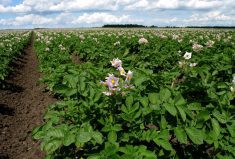The question of how different crop production would be if plants could fix their own nitrogen has been at the forefront of researchers’ work and stakeholders’ interests for more than 60 years. Aside from the ability of soybeans and edible beans to fix their own nitrogen, researchers have sought to find the same process for other crops.
It was a decade ago that a company from the United Kingdom — Azotic Technologies — finalized the development of a biological seed treatment that would enable a corn plant to fix nitrogen in the root zone. The work began in 1960 at the University of Nottingham in England and continued until 1988 when researcher Edward Cocking discovered a bacterium in sugar cane — one of roughly 500 different bacterial strains — that could supply up to 50 per cent of a sugar cane plant’s nitrogen needs.
Ten years later, two companies have derived biological treatments, each with a unique mode of action which helps plants capture nitrogen from the atmosphere for a variety of crops including potatoes. Corteva Agriscience has brought Utrisha N, a foliar treatment, to the market while Syngenta has Envita, which is derived from Cocking’s research more than 30 years ago and can be applied either in-furrow or as a foliar treatment.
Read Also

Could crop sharing be a viable option for your farm?
Crop sharing could be a good option for young and beginning farmers.
Utrisha N
The 2022 growing season was the first in this country for Utrisha N, with higher than expected uptake among corn growers in Eastern Canada and canola growers in Western Canada, according to Corteva. The company expects Utrisha N will also be used in cereals, soybeans and horticulture crops.
According to Mark Versluys, specialties business leader with Corteva Agriscience Canada, grower uptake and response have been positive.
“We’re still running through the trial data, but it looks very strong,” says Versluys. “Feedback has been extremely positive on user experience, including application. There was a strong reaction regarding biologicals in general and Utrisha N, in particular, on the survey which was sent out to growers. As well, there was a very high response rate relative to other non-biological surveys that have gone out. The expectation is for rapid growth in this segment going forward.”
Referred to as a nutrient efficiency biostimulant in company literature, Utrisha N enters the plant through the stomata in leaves. Once inside, its active ingredient — Methylobacterium symbioticum — colonizes and converts nitrogen gas from the air into ammonium, providing a constant supply of usable nitrogen to the plant.
In May 2022, Corteva Agriscience received certification from the Organic Materials Review Institute for the use of Utrisha N in organic farming in Canada. Versluys says he anticipates Utrisha N will have an excellent fit with potatoes since it’s an opportunity to supplement the nutrient needs of this high-value crop with a sustainable form of nitrogen. The 2022 growing season saw a number of Utrisha N trials for potatoes with high-profile growers and consultants. Anecdotal information referred to healthier looking, more robust plants in some situations.
“A plant with access to all of its nutritional needs will be more able to fend off pests, diseases and other environmental stressors,” says Versluys. “Since Utrisha N allows the plant to have access to nitrogen all season long, it would contribute to this state.
“It’s a fully supplemental source for the plant, allowing the fertility plan to meet its potential by eliminating having to pull nitrogen from a single source. Conventional nitrogen sources have limitations with respect to the prospect of volatilization or leaching.”
In addition to supplementing the supply of nitrogen to plants during the season, products such as Utrisha N could attract more attention as a way to address environmental concerns as the drive for sustainability becomes more prominent in agriculture. Company literature from Corteva states the use of the product carries no risk of leaching into water tables or releasing additional greenhouse gases.
The plan for Corteva is to have farmers use Utrisha N as a complementary product within existing fertility plans to maximize their potential. It is also the company’s first step into the biologicals space in Canada, with more entrants to come in the near future.
Envita
It has been a long journey for Envita from its arrival in Canada by way of Azotic Technologies to today. Like Corteva’s biologics entrant, it’s expected Envita’s highest uptake will be for corn in Eastern Canada and canola in Western Canada, although Syngenta says there’s been interest in its use for cereals, soybeans, pulses and potatoes as well. The technology also recently received approval for organic use in Canada.
“Envita is a perfect fit for Canadian growers,” says Nathan Klages, biological business manager for Syngenta Canada. “We continue to evaluate new biological products and will be adding to our portfolio in the coming years.”
The single rhizobial bacterium Cocking isolated in 1988 — Gluconacetobacter diazotrophicus — remains the active ingredient in Envita. According to Syngenta, the bacterium fixes nitrogen from the air soon after Envita is applied, providing an additional N source where and when it is needed the most for yield.
Cocking found G. diazotrophicus thrives in the intercellular (outer) environment of sugar cane, forming a symbiotic relationship with the plant. Azotic Technologies has now determined the bacterium also functions intracellularly — within the plant.
Klages states the response to test plots of Envita within the potato sector has been strong.
“Under irrigated and non-irrigated situations, we’ve seen very positive results during field-scale comparisons,” he says. “Field-applied nitrogen is not always plant-available due to environment or the weather, root development and the nitrogen cycle, so Envita helps fill that nitrogen gap.”
Field-scale trials conducted across Canada during 2020 and 2021 showed crops treated with Envita out-yielded untreated check plots approximately 80 per cent of the time. The product will be available from Syngenta for the 2023 growing season.
Klages considers N-fixing biological products a game changer for agriculture, and he says it’s something growers have been waiting for.
“Syngenta actively promotes best management practices and stewardship with growers, with a goal toward greater sustainability,” he says. “Envita provides an opportunity for more crops to be capable of fixing atmospheric nitrogen.”
Klages says he sees a need for Envita in regions like Manitoba and Ontario which are seeing increased calls for better nutrient management in soils, especially in areas where watercourses are nearby. He adds it could also be a tremendous benefit to potato producers in Prince Edward Island who are trying to reduce soil erosion while improving water quality.
Grower survey
A recent survey of roughly 800 Canadian producers revealed a majority believe their crops could benefit from alternative sources of nitrogen.
In the survey conducted by Corteva Agriscience, growers said they would consider using biostimulants and that they regarded biologicals as a viable, cost-effective and environmentally sensitive option to help their crop nutrient plans.
The survey also showed a level of confusion regarding biostimulants and differentiating between biologicals and micronutrients. Growers did express a desire to learn more about biologicals and how they work.
Specific results include:
- 78% of participants were concerned about nitrogen loss in their fertility program
- 95% said sustainability in their crop inputs is important
- 89% said they believe their crops would benefit from a supplemental source of nitrogen
- 80%+ would consider adding a biostimulant to their fertility plan
- 79% are using biologicals or biostimulant products or are interested in learning more about them
– This article was originally published in the 2023 edition of the Potato Guide.
















